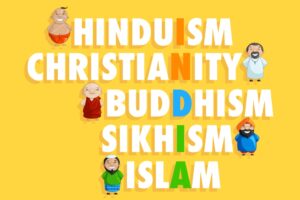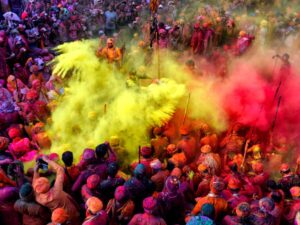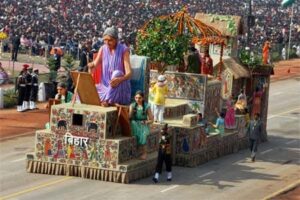From Languages to Landscapes: Exploring India’s Incredible Diversity”
India is a land of unparalleled diversity, a vibrant tapestry of cultures, languages, religions, and traditions woven together across its vast expanse. The sheer variety and complexity of India’s diversity make it a unique and fascinating country that has captured the imagination of people around the world. From the towering Himalayan peaks in the north to the sun-kissed beaches of the south, from the bustling metropolises to the tranquil rural landscapes, India’s diversity is both geographical and cultural, creating a rich mosaic that reflects its complex history and dynamic present.
Languages to Landscapes: Exploring India’s Incredible Diversity” which are as follows:
Geographical Diversity:
India’s geographical diversity is nothing short of astounding. It is home to an array of landscapes, each with its own distinct characteristics. The northern region is dominated by the majestic Himalayan mountain range, with peaks that soar to dizzying heights and valleys that cradle lush greenery. The northeastern states, often referred to as the “Seven Sisters,” are a treasure trove of biodiversity, with dense forests, roaring rivers, and a unique blend of indigenous cultures.
Moving southwards, the fertile Gangetic plains stretch across the heart of the country, nurturing a rich agricultural tradition that has sustained communities for millennia. The Thar Desert in the northwest, on the other hand, is a stark contrast, with its golden sands and arid climate. The western coastline offers a stunning contrast, with picturesque beaches and bustling port cities, while the eastern coast is renowned for its intricate network of deltas and estuaries.

Cultural Diversity:
India’s cultural diversity is equally mesmerizing. With a history dating back thousands of years, the country has been a melting pot of civilizations, resulting in a breathtaking array of cultures, traditions, and lifestyles. The roots of Indian culture can be traced to the ancient Indus Valley Civilization, which flourished around 3300–1300 BCE, leaving behind a legacy of advanced urban planning, art, and script.
Religious Plurality:
One of the most striking aspects of India’s diversity is its religious plurality. The country is the birthplace of major religions such as Hinduism, Buddhism, Jainism, and Sikhism. Hinduism, the largest religious group in India, is characterized by a multitude of deities, rituals, and philosophical schools. The holy city of Varanasi on the banks of the Ganges River is a sacred hub for Hindu pilgrims, while the annual Kumbh Mela attracts millions of devotees from across the country.
Buddhism, founded in India by Siddhartha Gautama, has left an indelible mark on the country’s cultural and architectural landscape. The ancient university town of Nalanda and the rock-cut cave temples at Ajanta and Ellora stand as testaments to the glory of Buddhist art and learning.

Jainism, with its emphasis on non-violence and asceticism, has also played a significant role in shaping Indian culture. The intricately carved Jain temples at Mount Abu and Dilwara are marvels of architectural craftsmanship.
Sikhism, born in the Punjab region, advocates equality, social justice, and service to humanity. The Golden Temple in Amritsar, the holiest shrine for Sikhs, exemplifies these principles and welcomes people from all walks of life.
Abrahamic religions such as Islam and Christianity have also found a home in India, contributing to the country’s religious mosaic. The Mughal architecture of the Jama Masjid in Delhi and the stunning churches of Goa are testaments to the enduring impact of these religions.
The Parsi New Near: History and Significance
Linguistic Diversity:
India is a linguistic kaleidoscope, boasting a staggering number of languages and dialects. The Eighth Schedule of the Indian Constitution recognizes 22 officially recognized languages, including Hindi, Bengali, Telugu, Marathi, Tamil, Urdu, Gujarati, and Punjabi. Each of these languages has its own script, literature, and cultural heritage, reflecting the diversity of India’s people.
The Linguistic Survey of India conducted during the British colonial era identified over 1700 languages and dialects, highlighting the linguistic richness that permeates every corner of the country. Language is a powerful marker of identity, and despite the dominance of certain languages, many regional languages continue to thrive, serving as a testament to the enduring cultural vitality of India.
Festivals and Traditions:
India’s calendar is studded with a dazzling array of festivals and celebrations, each offering a glimpse into the cultural tapestry of the nation. Diwali, the Festival of Lights, is celebrated with great fervor across the country, symbolizing the triumph of light over darkness. Holi, the Festival of Colors, is a joyous occasion where people come together to play, dance, and exchange vibrant hues. Eid, Christmas, Pongal, Baisakhi, and Durga Puja are just a few examples of the myriad festivals that showcase India’s religious and regional diversity.

Cuisine:
Indian cuisine is a tantalizing blend of flavors, spices, and techniques that reflect the country’s diversity. Each region has its own culinary traditions, resulting in a staggering variety of dishes that cater to diverse tastes. From the spicy curries of the south to the aromatic biryanis of the north, from the delectable sweets of Bengal to the savory snacks of Gujarat, Indian cuisine is a gastronomic adventure that mirrors the complexity of its culture.
Unity in Diversity:
Amidst this incredible diversity, there is an underlying thread that weaves India together—the spirit of unity. Despite the multitude of languages, religions, and cultures, the people of India have managed to coexist harmoniously for centuries. This unity in diversity is best encapsulated in the concept of “Vasudhaiva Kutumbakam,” which translates to “the world is one family.” This philosophy reflects the Indian ethos of inclusiveness and respect for all beings, regardless of their differences.

Challenges and Opportunities:
While India’s diversity is undoubtedly a source of strength, it also presents challenges. The country grapples with issues such as social inequality, religious tensions, and linguistic divides. Balancing the preservation of cultural traditions with the need for progress and modernization is an ongoing struggle.
However, India’s diversity also offers immense opportunities for cultural exchange, economic growth, and innovation. The country’s pluralistic heritage has fueled a vibrant creative industry, with art, music, literature, and cinema flourishing in various languages and styles. The IT boom in cities like Bangalore has catapulted India onto the global stage as a technological powerhouse.
In recent years, there has been a growing recognition of the value of diversity in fostering innovation and creativity. Businesses and organizations are increasingly embracing the idea that diverse teams lead to more robust problem-solving and a broader range of perspectives.
In Conclusion:
India’s diversity is a true wonder of the world, a testament to the resilience, adaptability, and creativity of its people. It is a land where ancient traditions coexist with modern aspirations, where multiple languages are spoken, and where countless stories unfold. The diversity of India is a source of inspiration and a reminder that humanity’s strength lies in its ability to celebrate differences while forging connections that transcend them. As India continues to evolve, its diversity remains an enduring source of pride and a beacon of hope for a harmonious world.
From Languages to Landscapes: Exploring India’s Incredible Diversity” exploring-indias-incredible-diversity. What is the Diversity of India




















[…] From Languages to Landscapes: Exploring India’s Incredible Diversity” […]
[…] From Languages to Landscapes: Exploring India’s Incredible Diversity” […]
Your point of view caught my eye and was very interesting. Thanks. I have a question for you.